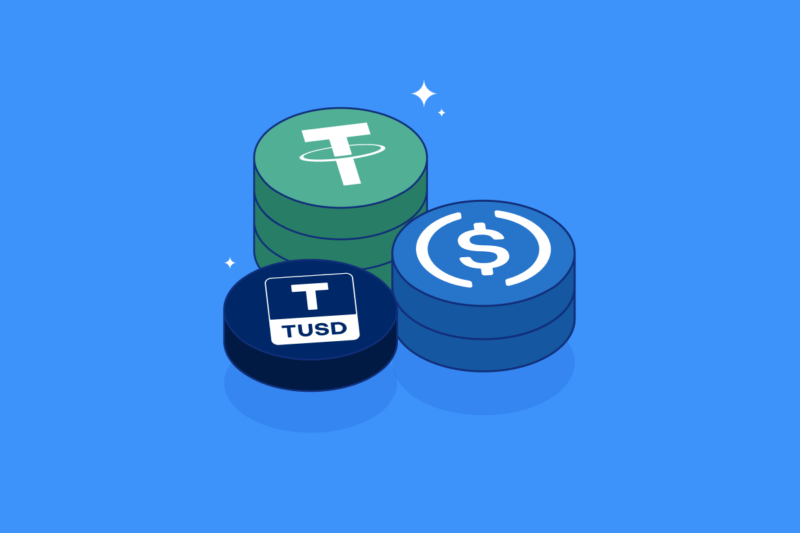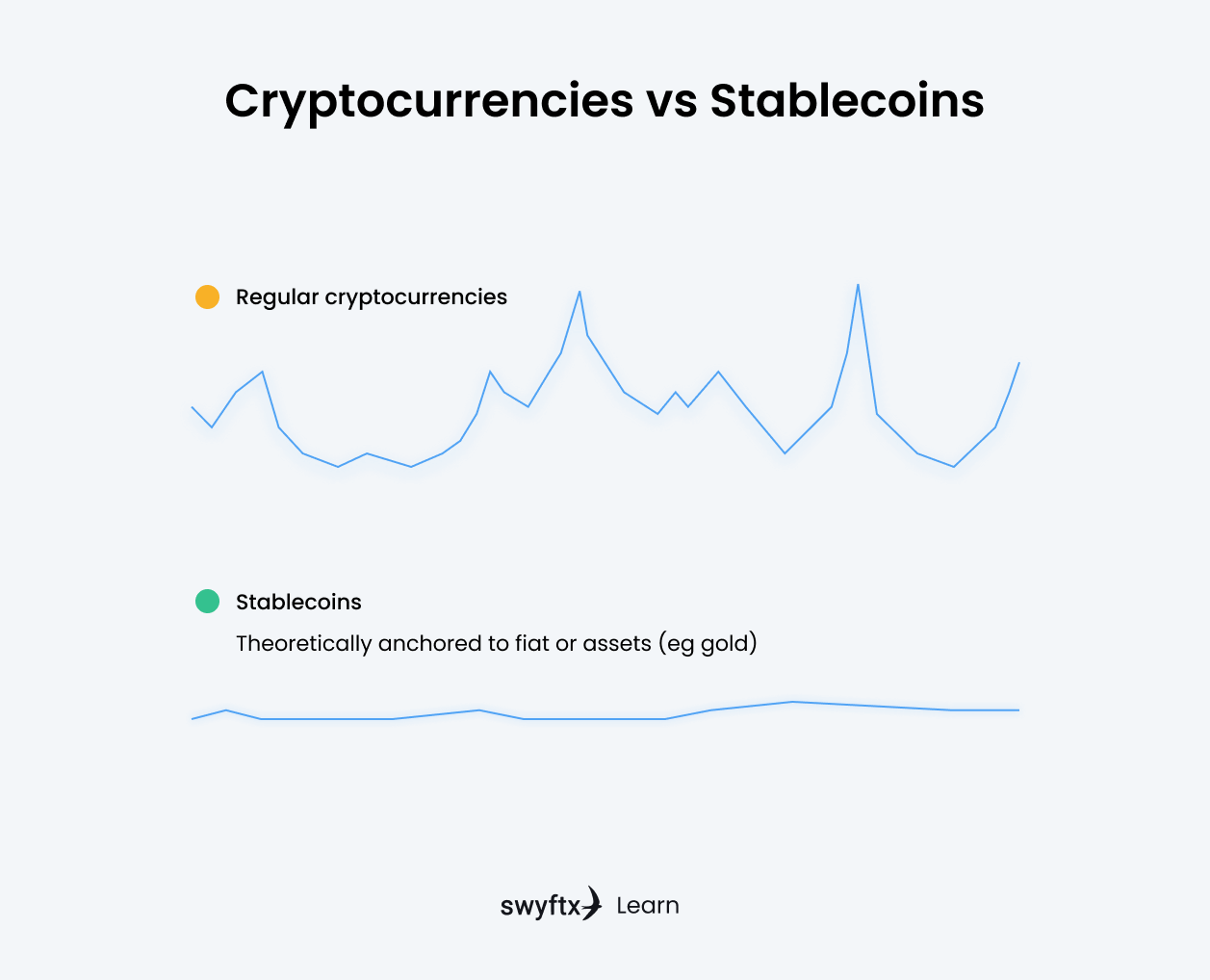
Stablecoins are a very important part of the crypto markets. In many ways, they are the foundation of almost all crypto trading. This is because stablecoins are designed (at least in theory) to be universal and non-volatile currencies that can be used to buy every other crypto asset. This article will explore what stablecoins are, how they work, and look at the different kinds of stablecoins.
Important To Remember
Although stablecoins are designed to be pegged to fiat currencies, there is no guarantee they will keep that peg. Take, for example, UST, Terra’s USD-pegged stablecoin. UST is an algorithmic stablecoin that lost its peg to 1 US dollar in May 2022, dropping as low as $0.06 USD.
What is a stablecoin?
A stablecoin is a type of digital currency that is designed to be pegged to a real-world asset or fiat currency. As a result, it is designed to be less volatile than other cryptocurrencies such as Bitcoin (BTC) and Ethereum (ETH).
With over 20,000 cryptocurrencies in existence, the majority of them are not Stablecoins. This means they can and do fluctuate based on forces including their market capitalization, how many coins are in circulation, or how many people are investing, etc.
Stablecoins arose when there was a need for stability in the crypto space. They still run on the same blockchain technology as other cryptocurrencies but are designed to be non-volatile. History has shown, however, that there is still a very real risk of stablecoins being volatile when they “lose their peg”.

Figure 1 – Cryptocurrencies vs stablecoins
Types of stablecoins and how they work
There are a few ways that stablecoins can aim to maintain price stability. Here are some examples of different types of stablecoins and how they work.
Pegged to fiat currency and backed by collateral
Some stablecoins are pegged to real-world fiat currencies, such as the U.S. dollar. The idea is that these are fiat-backed stablecoins, backed by an equal amount of that fiat currency used as collateral. When the coin is pegged, the value aims to mirror whatever the value of that outside asset is.
USD Tether (USDT) and USD Coin (USDC) are the two most prominent fiat collateralized stablecoins designed to be pegged to the U.S dollar.
Pegged to commodity
Other stablecoins are designed to be pegged to real-world commodities like precious metals, such as gold. The concept behind these coins is that they are backed by an equal amount of gold as collateral. Like the fiat-pegged stablecoins, these coins aim to mirror the value of the external asset, in this case, gold.
PAX Gold (PAXG) and the Perth Mint Gold Token (PMGT) are two excellent examples of commodity-backed stablecoins.
Pegged to crypto stablecoins
When a stablecoin is pegged to another cryptocurrency, these particular digital assets become its collateral and will have coins locked up to attempt to maintain the peg. This type of crypto-backed stablecoin relies on smart contracts, rather than a central issuer as with USDT and USDC. When being pegged to another crypto the ratio is rarely 1:1 as the prices are often volatile.
DAI is a great example of a successful stablecoin that is pegged to a digital asset, one that survived the 2018 crypto crash relatively unscathed.
Did You Know?
These types of stablecoins are also known as crypto collateralized stablecoins.
Algorithmic stablecoins
This type of stablecoin does not rely on fiat or crypto as collateral. Instead, it has a smart contract set up that attempts to adjust its market cap based on price fluctuations. If the price falls it will incentivise a reduction of the total supply, so the price goes up again. If the price increases too much it will incentivise an addition of tokens into circulation for the price to come back down. These types of stablecoins are commonly used in DeFi projects.
The most well-known example is TerraUSD (UST), but that has since proven to be a failed attempt. There are, however, several other successful algorithmic stablecoins, such as Ampleforth (AMPL) and the Tron network’s Decentralized USD (USDD).
Popular stablecoins
Tether (USDT)
USD Tether (USDT) is the most popular stablecoin in the world. It is designed to be pegged to the U.S dollar. USDT is reportedly backed by 3-31% cash, with the rest of its reserves allegedly made up of assets like commercial paper, loans, and corporate bonds (Figure 2).

Figure 2 – Reported Tether reserves as of May 2021
USDT is issued by a Hong Kong based company called Tether. Tether is said to have a reserve of real USD equivalent to the amount of USDT they provide to their users. Tether undertakes quarterly audits, but so far these have not been independent audits.
Historically, Tether has lost its peg several times, briefly, going as low as $0.92 USD. The most recent example of this was when UST collapsed in May 2022 and crypto investors sought refuge in more “secure” stablecoins. As the largest stablecoin and subsequently, the highest traded cryptocurrency, Tether does sometimes lose its peg requiring assets to be moved to restore its dollar parity.
USD Coin (USDC)
USD Coin is very similar to USDT. It is a stablecoin that is designed to be pegged to the U.S dollar. It is the second most popular stablecoin in the world, behind USDT. USD Coin is reportedly backed by 61% cash and government money market funds, with the rest consisting of commercial paper, corporate bonds, and other assets (Figure 3).

Figure 3 – USDC reserves as of July 2021
USDC was created by the Centre Consortium, which consists of influential crypto and blockchain companies, Circle and Coinbase.
Binance USD (BUSD)
Binance USD (BUSD) is a popular fiat-backed stablecoin that is issued by the world’s largest cryptocurrency exchange, Binance, rather than an external authority. BUSD is reportedly backed by 96% cash, with the rest of its reserves made up of treasury bills. BUSD is audited quarterly and regulated.
DAI
DAI is one of the most well-known crypto-backed stablecoins. It aims for a 1:1 ratio with the U.S. dollar, however, instead of the dollar being the collateral, users must lock up their Ether (ETH), which becomes the collateral instead. The stablecoin operators are the network of people using DAI, facilitated by Maker DAO, a decentralized governance protocol. DAI’s reserves are 100% Ether, and they are assured by smart contracts.
TrueAUD and TrueUSD
TrueAUD and TrueUSD are stablecoins that are issued by a California-based company, TrustToken. As the name suggests, these tokens were born out of a dire need for investors to be able to trust the stablecoins they are exchanging their fiat currency for. All of these tokens are backed by 100% cash reserves. Like a breath of fresh air for investors, TrustToken provides real-time auditing and regulation.
Interesting Fact
TrustToken provides real-time auditing of their reserves through TrustExplorer, which delivers an unprecedented amount of transparency.
PAX Gold and PMGT
PAX Gold (PAXG) is one of several stablecoins that are backed by 100% reserves of gold held by the Paxos Trust Company. Investors who hold PAX Gold tokens, also own the underlying physical gold.
The Perth Mint Gold Token (PMGT) is very similar. Every PMGT token is a digitised version of a GoldPass certificate, which is 100% backed by physical gold held in the Perth Mint’s vaults.
Key Takeaway
Perth Mint Gold Token (PMGT) is a gold-backed stablecoin that is officially guaranteed by the Government of Western Australia. Each token represents physical gold held in a high-security vault.
Why do we need stablecoins?
Volatility limits crypto uses
Price volatility in the crypto market is part of what got crypto the attention it has today. Some people even love the dramatic price changes when it comes to investing. The price can move quickly and aggressively, especially in comparison to the traditional stock exchange. It makes for attractive conditions for day traders and swing traders who make a living out of buying and selling short-term trend reversals. However, when the majority of coins are volatile, it limits other use cases.
Better for making payments
Stablecoins may be a more efficient way to make a payment using cryptocurrency as opposed to using more volatile cryptocurrencies. When paying using another cryptocurrency it can get complicated as the price changes from one hour to the next. If you think about the guy who purchased two pizzas for 10,000 BTC in 2010, you can see why this might be a flawed system for payments.
Easier to exchange than fiat
Stablecoins are on many exchanges for trading, and some see them as a temporary store of value, while still affording easy access to the crypto market. For example, if you have Bitcoin and the price goes up and you want to take some of your profit out, you can trade it for a stablecoin. You can then invest it back into Bitcoin or another cryptocurrency whenever you like, as an alternative to exchanging more fiat which usually has a higher rate.
How can I buy stablecoins?
Stablecoins are on almost all exchanges as it makes their customer experience easier and typically keeps the fees lower than always exchanging to fiat. Although many of them are pegged to the U.S. dollar, they are still found on global exchanges and can be purchased with national currencies. For instance, you can buy a range of stablecoins and digital currencies like USDT, USDC, BUSD, and TUSD on the Swyftx exchange.
Wrap up
Stablecoins are a type of cryptocurrency whose value is meant to be less volatile than other coins like Bitcoin or Ethereum. They are a vital part of the crypto economy. Some stablecoins are pegged to a fiat currency such as the U.S. Dollar or a real-world asset such as gold. Although the pegging helps to maintain price stability, the coin can still fluctuate like other currencies. They can fluctuate based on things like market capitalization, how many coins are in circulation, or how many people are investing.
Disclaimer: The information on Swyftx Learn is for general educational purposes only and should not be taken as investment advice, personal recommendation, or an offer of, or solicitation to, buy or sell any assets. It has been prepared without regard to any particular investment objectives or financial situation and does not purport to cover any legal or regulatory requirements. Customers are encouraged to do their own independent research and seek professional advice. Swyftx makes no representation and assumes no liability as to the accuracy or completeness of the content. Any references to past performance are not, and should not be taken as a reliable indicator of future results. Make sure you understand the risks involved in trading before committing any capital. Never risk more than you are prepared to lose. Consider our Terms of Use and Risk Disclosure Statement for more details.
